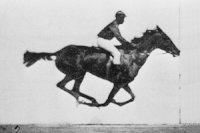Zoopraxiskope

Sequence of images of a galloping racehorse ( Eadweard Muybridge 1887)
The zoopraxiscope is a projection device developed by Eadweard Muybridge in 1879 for chronophotographically generated images. It is a disk-shaped stroboscope that uses an incandescent lamp to project the sequence of individual images onto a screen.
For the first time, Muybridge recorded individual movement phases of a galloping horse . He had been assigned to find out if there was a moment when none of the horse's legs touched the ground. To do this, he set up 12 cameras along the racetrack and tensioned contact wires that triggered the cameras when the horse moved. Then he ran the individual photos in quick succession. He developed the zoo practice scope for reproduction.
Timetable
- from 1600: Flip book - flip book with individual images
- from 1671: Laterna magica - magic lantern: early device for image projection
- from 1825: Thaumatrop - miracle disc with two threads
- from 1830: Phenakistiskop - phantascope, miracle wheel or wheel of life
- from 1832: stroboscope - magic disks: flash unit
- from 1834: Zoetrop - miracle drum with slots
- from 1861: Mutoskop - stereo animation sheets per stroboscope
- from 1877: Praxinoscope - electrical high-speed viewer using a mirror arrangement
- from 1879: Zoopraxiskop - projection device for chronophotographically generated serial images
- from 1880: Kaiserpanorama - popular mass medium with stereoscopic picture series
- from 1886: Electrotachyscope - projection device for row images
- from 1891: Kinetoskop - first film viewer
Web links
Commons : Motion Studies by Eadweard Muybridge - Images and Media Files
Individual evidence
- ↑ Midori Kitagawa, Brian Windsor: MoCap for Artists: Workflow and Techniques for Motion Capture . CRC Press, 2012, ISBN 978-1-136-13966-6 , pp. 2 ( side view in Google Book search).
